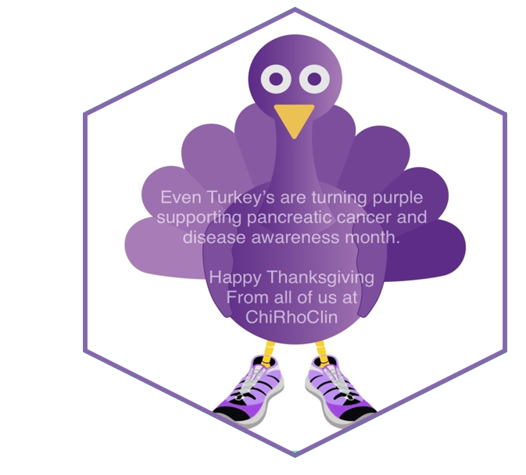Happy Thanksgiving 2022
Pancreatitis and Thanksgiving
As we get ready to gather around delicious homecooked meals and celebrate our holiday traditions, it’s important to note that pancreatitis doesn’t take the day off. Living with chronic or acute pancreatitis is trying on a regular day, but the holidays are wrought with flare ups and undue stress. For this special holiday edition of the ChiRhoClin Newsletter, we want to highlight the differences between chronic and acute pancreatitis and provide some helpful tips to help navigate the holidays and avoid unwanted instances of inflammation or irritation of the pancreas.

Acute VS Chronic Pancreatitis
When the pancreas becomes inflamed over a short period of time (days/weeks), it is classified as Acute Pancreatitis. Severe pain in the abdomen, steadily growing worse and traveling along your back is the most common symptom of the onset of acute pancreatitis. Other common symptoms include indigestion, high temperature fevers (38C or more), yellowing of the whites of the eyes and of the skin (jaundice), tenderness or swelling of the belly, and tachycardia (fast heartbeat) or rapid breathing (NIDDK).
According to the National Institutes of Health, eating fatty foods or drinking alcohol may worsen symptoms. Leaning forward or curling into a ball may help to relieve the pain, but lying flat on your back often makes it worse (NHS).
Acute pancreatitis occurs suddenly and is a short-term condition. Most people with acute pancreatitis get better, and it usually dissipates in several days with treatment. Some people can have a more severe form of acute pancreatitis, which requires a lengthy hospital stay.


Should the pancreas not heal or improve, rather, the inflammation worsens over time leading to lasting damage, then acute pancreatitis develops into chronic pancreatitis (CP). CP comes with a myriad of complications, including chronic pain in the abdomen, maldigestion, malnutrition and malabsorption, scars along the pancreas, diabetes, pancreatic cancer and osteopenia (decreased bone density), osteoporosis (decreased bone mineral density/mass), and bone fractures. Many patients with CP will even have calcifications of the pancreas that appear on a computerized tomography (CT) scan.
CP can take many years to develop, so taking preventative measures is key. Frequent flare-ups, diabetes, and problems digesting fat are associated with CP, though patients with CP may still have a good outlook if they talk to their doctor and follow a management plan (AGA).
This Thanksgiving, it’s important to follow these tricks to help alleviate or even prevent flare ups:
1) Alcohol should be avoided, as people with pancreatitis have a pancreas that is not properly processing alcohol. Juice, cider, and teas are suggested alternatives.
2) Sugared nuts, heavy dressings and high fat sides are not recommended. Instead, consider substituting “lite” or fat-free alternatives like sliced fruit/vegetables or toasted (sugar-free) nuts.
3) Finally, consider fat-free desserts to prevent flare-ups.

